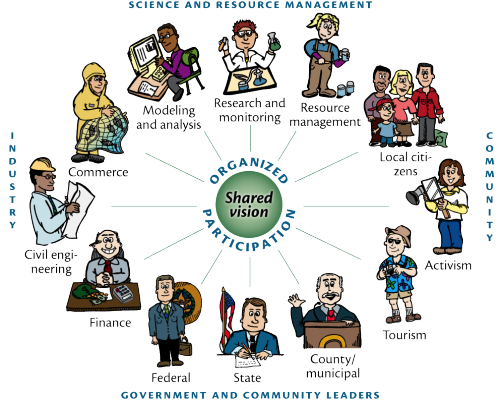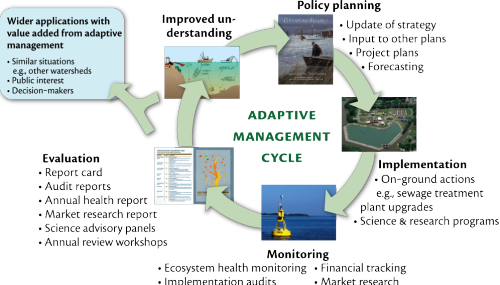Ecosystem Based Management: The challenge of change
Martina Gonzalez Mateur, Adriane Michaelis, Suzi Spitzer ·Martina Gonzalez Mateu, Adrianne Michaelis, Suzi Spitzer
Increasing knowledge about ecosystem dynamics over the past several decades has allowed us to make positive changes in our approach to resource management. In the past, management goals primarily focused on protecting single species, and tried to restore ecosystems to historical states that were considered desirable. This management strategy proved to be inefficient, and managers have now turned to a new approach known as Ecosystem Based Management (EBM). By broadening the management focus from individual resources to an ecosystem scale, ecosystem function and resilience became the new priorities. EBM is the current ideal management strategy, but its underlying challenges must be considered, addressed and overcome.
One of the fundamental ideas in EBM is the integration of the social and ecological dimensions of a system (UNEP, 2011; Boesch, 2006). This means that stakeholders are involved in the decision-making process, and final management decisions are the results of collectively accepted compromises (Figure 1). However, the identification of all stakeholders, the challenges of cross-jurisdiction management, the difficulty of reaching compromises that acknowledge and prioritize several different uses of a single resource, and the barriers of scientific communication to the public or to other scientific disciplines make the integration aspect of EBM very complicated. To overcome these problems, the different parties involved must be willing to compromise, requiring governance that promotes cooperation between sectors. It is also important that the public is involved and engaged in ecosystem stewardship (UNEP, 2011). To accomplish these objectives, communication between different groups is essential, and ideally facilitated by specialists. An example of this is the 
A second component of EBM entails the need for adaptive management of the system. Adaptive management involves enacting experimental environmental policies that are monitored by managers who can learn from the outcomes and incorporate new knowledge to adjust or construct updated management strategies (Lee, K., 1999) (Figure 2). An example of the application of adaptive management can be found within the original Chesapeake Bay Program objectives. These included very ambitious restoration goals that were revised multiple times over the years, after they were not fully accomplished in the original time frame. This approach is common when there is incomplete knowledge of an ecosystem, and flexible management goals are necessary to cope with the unknown variability and dynamics of any ecosystem. By helping managers learn more about the system, adaptive management could help detect surprises and calculate risks more effectively.
The third element that guides EBM is the precautionary principle, which states that if the consequences of an action are potentially adverse, the action should not be allowed to proceed (Boesch, D.F., 2006). Taking risks is an inherent part of management, thus it is important that the precautionary principle does not become an obstacle and result in complete inaction. For example, when the California condor population in the wild dropped to twenty-two individuals in 1982, managers made the risky decision to capture all of the wild individuals by 1987, and start a captive breeding program. Although the outcome was filled with uncertainty at the time, the recovery of the California Condor is now an example of a conservation success (Walters et al. 2010). In cases like this, the application of the precautionary principle must take into account the risks of both action and inaction, especially when the latter can lead to irreversible losses.

The last of the four guiding principles of EBM is sustainability, and this concept is strongly linked to resilience. It is important for managers to define resilience, as it is often misinterpreted. Resilience can be understood as the magnitude of disturbance that a socioecological system can endure without losing its functions and controls (Carpenter, S. et al. 2001; Boesch, D. F., and Goldman E.B., 2009). Taking this definition into consideration should help to maintain the broad management focus of ensuring the provision of different ecosystem services, rather than protecting single resources or species.
EBM has been practiced on terrestrial ecosystems for over 50 years, but only recently has been applied to marine and coastal environments (UNEP, 2011). To outline the main facets of marine EBM, the EBM Consensus Statement in 2005 proposed a list that included nine key elements. (McLeod et al. 2005). Scientists outlined many desirable but somewhat unrealistic goals such as attaining historical levels of biodiversity, or involving all stakeholders through participatory governance. These types of guidelines, though arguably lofty, serve as important initial steps towards successful EBM.
As resources become increasingly depleted and ecosystem services are lost, acknowledging the link between society and environmental health is crucial. Through effective communication and multi-scale cooperation, change is possible and most challenges of EBM can be overcome.
References:
- Boesch, D. F. (2006). Scientific requirements for ecosystem-based management in the restoration of Chesapeake Bay and Coastal Louisiana [pdf]. Ecological Engineering 26(1), 6–26
- Boesch, D. F. and E. B. Goldman (2009). Chesapeake Bay, USA, in Ecosystem-Based Management for the Oceans. K. McLeod and H. Leslie (eds) pp. 268–293. Island Press.
- Lee, K. (1999). Appraising adaptive management [pdf]. Conservation ecology, 3(2), 3.
- McLeod, K. L., J. Lubchenco, S. R. Palumbi, and A. A. Rosenberg (2005). Scientific Consensus Statement on Marine Ecosystem-Based Management.
- UNEP (2011). Taking Steps toward Marine and Coastal Ecosystem-Based Management – An Introductory Guide [pdf].
- Walters, J.R., Derrickson, S.R., Fry, D.M., Marzluff, J.M., Wunderle, J.M. Jr., (2010). Status of the California Condor (Gymnogyps californianus) and efforts to achieve its recovery [pdf]. The American Ornithologist's Union 127(4):969-1001.
Next Post > Does rising sea level signal the end for LUMCON, or a beginning?
Comments
-
Stephanie Siemek 9 years ago
Science is a process of research using experimentation and observation; therefore, why should ecosystem based management (EBM) be any different? We have used science in order to understand how the natural world works and now it must be used in order to understand how to sustain it. There are still many unknowns, but we must act confidently with the knowledge we have before it is too late.
Taking a risk is not only necessary for management, but it is the only way we can expand our knowledge and fill in the gaps. As the article states, it is important to understand the risks of action and inaction, which is where we are today on many issues, such as climate change. While trying to find more evidence that supports it is from anthropogenic causes, we are losing time that could otherwise be used to mitigate or slow it down.
It takes cooperation and understanding to move forward in EBM and for many environmental issues that seems to be the main barrier. As we stand on the sidelines in our debates, the environment slips deeper and deeper into a slump. Will it then be when ecosystems have surpassed their thresholds that all parties will finally come together and agree on an action?
-
Bernadie Jamora 6 years ago
Ecosystem should be equally manage by the people. We have a great role i our society today especially in our environment. " We used the natural resources for free so we should take good care and manage of it as willing as we can.
-
Whitney Hoot 9 years ago
To continue the discussion on risk and the importance of the precautionary principle in EBM, I think we should consider the role of stakeholder and community engagement in risk assessment. In single-species management, risk is relatively easy to assess; however, in EBM, we are dealing with incredibly complex systems, interacting processes, and multiple stressors. How can input from community members and other stakeholders assist managers in prioritizing conservation goals? Valuation of ecosystem services always seems to have a social/cultural component, and the calculation of value is an important aspect of risk assessment. So, it seems crucial that the community is engaged at this stage of the management process.
-
Chih-Hsien (Michelle) Lin 9 years ago
I agree with Stephanie. Natural perturbation is impossible to prevent, but anthropogenic causes are avoidable through enhanced public eduction, monitoring, and assessment, and through the establishment of effective management and policies.
Ecosystem based management (EBM) actions are no doubt important for sustainable use of resources. It should be concerned more about coastal and marine environment since it starts late compared to terrestrial ecosystem. For example, the great sea fisheries have gone through serious overexploitation because of increased seafood demand driven by rapid growth rate of human population. It is widely believed that the collapse of global fishery resources are due to inappropriate fishery management. The conflict between multiply countries (such as South China Sea) about the issue of overlapped economic zone (EZZs) is truly challenging for change in environmental issue.
-
Detbra Rosales 9 years ago
I agree with Stephanie and Michelle as well, risk taking is a precursor for management and science. Nicolaus Copernicus took a risk and went against the common knowledge and proposed that the sun not the earth was the center of the solar system. Yes, he did some observation and scientific analysis, but he took the chance. Perhaps if he never reported his idea of heliocentrism, we would have never known about it or it might have taking longer for us to understand this concept. One of the reading we had "Regulating exposure to radio frequency fields" gave an example of the precautionary principle. During WWII there was this idea that high level exposure of RF energy was hazardous to the public. Several countries adopted the precautionary measures to limit the pubic from these RF fields, but there was no real scientific evidence that exposure to RF fields was harmful to humans. I thought it was interesting that some of these countries limited low RF fields exposure from cellular base stations but they did not apply these measures to medical equipment or even cell phones that have higher exposures. How much precaution should we take when making decisions? When should we stop and just take the risk?